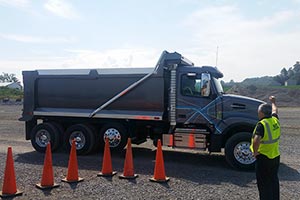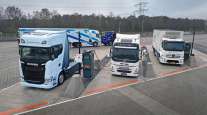Volvo Touts New Crawler-Gear Option for Off-Road Trucks

SHIPPENSBURG, Pa. — Managers of Volvo Trucks North America talked up the improved fuel efficiency and increased driver productivity of their new crawler-gear option on the I-Shift automated manual transmission designed for applications where very slow speeds are used.
The original equipment manufacturer hosted a ride-and-drive event for reporters and editors June 28 at its construction equipment facility here to demonstrate the capabilities of I-Shift with crawler gears on its VHD model vocational trucks.
The press “had an opportunity to experience some of the very first ones we’ve built,” Wade Long, director of product marketing for VTNA, said in an interview with Transport Topics. The transmission is available on Volvo’s new 2017 engines that will have to comply with the federal greenhouse-gas update effective Jan. 1. It will be available in November on Volvo’s D13 engine and in January with the D11 and D16 engines.
The company announced the I-Shift with crawler gears in March, saying the AMT would be “appropriate for both vocational and on-highway applications.” The new AMTs are intended for concrete mixers with curb-pouring capability, asphalt paving “and other low-speed tasks, as well as improved startability for heavy-haul,” the OEM said.
The AMT comes in two versions: 14 forward gears, including one low crawler and one ultra-low crawler; and 13 forward gears, including one low crawler. The 13-speed is typically used for highway and heavy-haul, while the 14-speed is for off-road, vocational applications such as mixers and dump trucks, Long said.
The event took place on the construction equipment demonstration area with a VHD off-road dump truck with the 14-speed, ultra-low crawler gear.
A benefit of crawler gears on vocationals, Long said, is improved fuel efficiency. “It allows us to speed up the rear-axle ratio.”
A typical dump truck, for example, would have a 3.73 or 3.90 rear-axle ratio so it could have “great startability,” but when it’s cruising down the highway at 60 to 65 mph, the engine would operate at 1,500 to 1,600 rpm, Long said.
With the ultra-low crawler gear, “we allow you to spec a very fast ratio — down in the 3.07 to 3.21 rear-axle ratio,” Long said. But while a truck is cruising down the highway at 65 mph, “you could be running in a sweet spot of the engine — about 1,350 rpm. “So every 100 rpm we slow down the truck, we save about 1.5% in fuel efficiency.”
“We are giving a vocational truck operation like a highway truck when it’s running down the highway,” Long said.
The other benefit is driver productivity, he said. The crawler gears allow a driver to pull up with heavy loads on steep grades and operate at “very, very slow speeds,” as low as 0.6 mph, he said. This is ideal for applications such as concrete mixers doing curb pouring, Long said.
Automated manuals do not require a clutch pedal for operation.
Volvo introduced AMTs in 2001 and brought them to North America in 2007, Long said. Today, about 88% of VTNA’s trucks use I-Shift.
As for cost, Long said automated manuals are more expensive than manual transmissions, due to electronics and other features. However, “in general, when we look at the driver productivity and the fuel-efficiency gains, we look at the total lifetime of product. That may be something that we can balance out a little bit when we look at a total cost of ownership.”
When asked about challenges in developing the I-Shift, he said that “the biggest challenge really was not the product. The mechanical design of the product worked very well.” Rather, “it was convincing the operators that the product can do all the start and stop, can shift correctly. “Drivers like to have the sense of control of the vehicle. They were the biggest resistance to moving the product into the marketplace.”
Ultimately, however, Long said that drivers feel “much more rested in a day. They’re not having to shift all the time.”
Class 8 trucks have a place for classic manual transmissions, fully automatic transmissions and automated manuals, Long said. For example, automatics currently are very good for trucks with frequent starts and stops, such as trash pickup, he said, but AMTs fulfill “a big portion of the application requirements” needed today.




